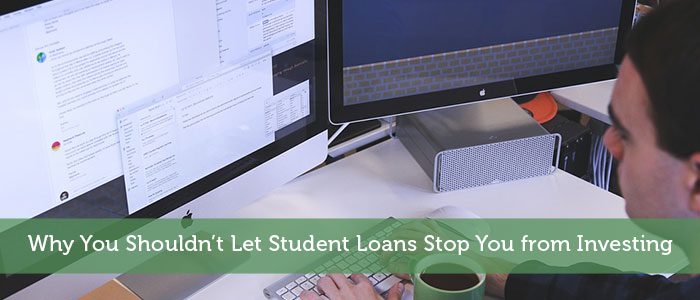By Miranda Marquit
It can be discouraging to look at your student loan balance. And when you see that huge number, it’s easy to become overwhelmed. You might be consumed with the idea of paying off all that debt before moving on with your life — and that includes investing for your retirement.
Getting out of debt is one of the keys to financial independence. But if most of your debt is in the form of student loans, it might make sense to get started with investing before you pay them all off. Here are some things to consider before putting off investing in your future entirely.
Take advantage of low, tax-deductible interest
First of all, student loans usually come with lower interest rates. With a credit card, you’re probably paying 17.99 percent — or more. But with a student loan, you’re probably at 6 or 7 percent. And in some cases, you might be able to refinance your student loan debt to an even lower rate, putting it in the 3 percent to 4 percent range.
Compare your student loan interest to the possibilities of investing. Historically, the S&P 500 has an average annualized return of right around 10 percent, according to Investopedia. If you’re paying 4 percent on your student loans, and you can earn 10 percent investing, you can come out ahead — even if you keep your student loans.
Not only do student loans usually have a lower interest rate compared to other debt, but the interest you pay is also tax-deductible. You don’t even have to itemize your deductions to take advantage of this tax deduction. The tax-deductible nature of your student loan interest means that it costs you even less.
Let compound interest work its magic
Compound interest is one of the great wonders of the financial world. The time your money spends in the market makes a huge difference when it comes to the final outcome.
Using a compound interest calculator, it’s possible to figure out how much money you could be missing out on if you wait to start investing.
Let’s say you’re 25 years old. You want to put an extra $300 toward your student loans each month and have them paid off by the time you’re 32. Then, you’ll start investing with a hope of retiring when you’re 60.
If you wait until you’re 32 to start investing, your money will be in the market for 28 years. Assuming an 8 percent return, that $300 a month will get you $343,219.79 by age 60.
But if you start at age 25, that $300 a month is invested for 35 years. Your end amount is potentially $620,340.49. That’s almost double the nest egg, just by starting seven years earlier.
You can do even better if you work for a company that offers a 401k with a match. When you put money toward retirement, your employer matches a portion of it. That’s free money, earning compound interest on your behalf, for even longer.
This isn’t just a numbers game, though. You should also consider the long-term cumulative effect involved.
Using a student loan prepayment calculator, you can compare the cumulative impact. For example, let’s say you have $45,000 in student loan debt with an average rate of 4.7 percent and a monthly payment of $300. You can save $14,418 in interest and pay off the loans in about 7.4 years with an additional payment of $300 ($600 total per month).
During that seven years, investing $300 a month has the potential to turn into $32,122.09. But cumulatively, if you start earlier and invest until you retire, the difference is almost $300,000.
That’s a big difference.
Do what’s right for you
These numbers might not mean much if you aren’t comfortable with having debt and you want the freedom of having it paid off.
If you’d rather start small, you can invest with a smaller amount. Try setting aside $100 a month for investing and use $200 a month to pay down your student loan debt faster. As you earn more money in the future, you can increase the amount you use to pay off debt and invest.
If you have an employer that offers a matching contribution, it makes sense to get the maximum match if you can. At the very least, invest enough in your employer’s 401k to get a matching contribution and start accumulating some compound returns.
Student loan debt can feel overwhelming. But if you can get your cash flow figured out and the payments under control, you don’t need to let student loan debt stop you from investing in your future.





